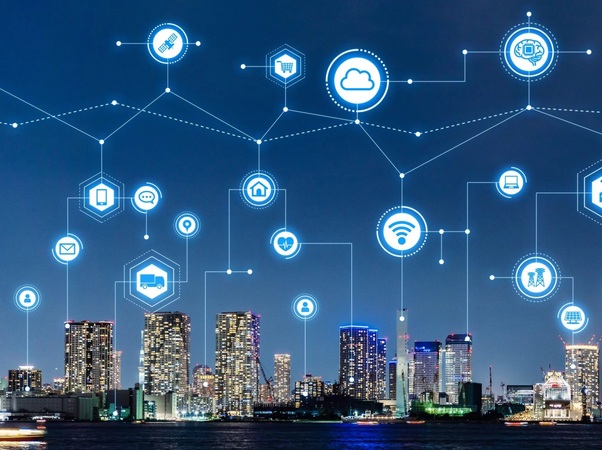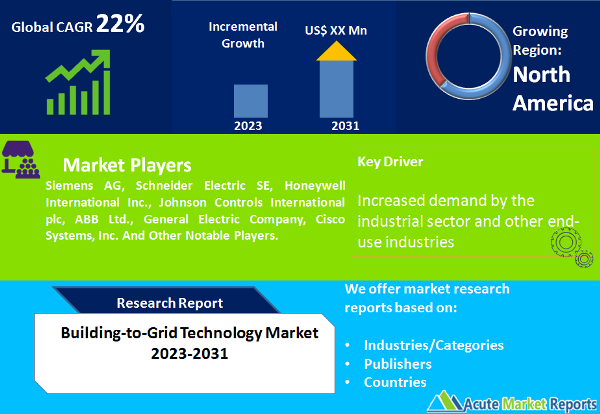
The building-to-grid technology market is expected to grow at a CAGR of 22% during the forecast period of 2024 to 2032. The technology refers to the integration of buildings with the power grid, enabling enhanced energy management and efficiency. This market is driven by the increasing need for sustainable energy solutions, advancements in smart grid technologies, and the growing focus on energy conservation. The market revenue for Building-to-Grid Technology has been steadily rising, and the compound annual growth rate (CAGR) indicates a positive growth trajectory. This technology allows for real-time monitoring and control of energy usage, demand response management, and the integration of renewable energy sources. By connecting buildings to the power grid, it enables the exchange of information and energy between them, creating a more efficient and resilient energy ecosystem. With increasing concerns about climate change and the need to reduce greenhouse gas emissions, there is a growing emphasis on sustainable energy solutions. Building-to-Grid Technology plays a vital role in optimizing energy usage, reducing wastage, and integrating renewable energy sources, aligning with global sustainability goals. The evolution of smart grid technologies has significantly influenced the Building-to-Grid Technology market. Smart grids enable bidirectional communication between buildings and the power grid, facilitating dynamic energy management, load balancing, and grid stability. The integration of smart grid functionalities with building systems enhances energy efficiency and grid reliability.

Sustainability Initiatives and Environmental Regulations
Sustainability has become a key driver for the adoption of Building-to-Grid (B2G) technology. Governments and organizations worldwide are implementing stringent environmental regulations and targets to combat climate change. B2G technology enables buildings to reduce their carbon footprint by optimizing energy usage, integrating renewable energy sources, and participating in demand response programs. For example, the European Union's Energy Performance of Buildings Directive mandates energy-efficient measures and promotes the use of smart technologies for energy management.
Advancements in IoT and Building Automation Systems
The proliferation of the Internet of Things (IoT) and building automation systems has significantly influenced the adoption of B2G technology. IoT sensors and devices enable real-time monitoring of energy consumption, occupancy patterns, and environmental conditions within buildings. This data is crucial for optimizing energy usage and implementing demand response strategies. Additionally, advancements in building automation systems allow for seamless integration of B2G solutions, enabling intelligent control and management of building systems.
Cost Savings and Operational Efficiency
Building owners and operators are increasingly focused on reducing operational costs and improving efficiency. B2G technology offers significant cost-saving opportunities by optimizing energy usage, reducing peak demand, and minimizing wastage. Through demand response programs, buildings can adjust their energy consumption based on grid conditions, taking advantage of lower electricity prices during off-peak hours. By implementing B2G solutions, buildings can achieve energy cost savings while maintaining optimal comfort levels for occupants.
Cybersecurity and Data Privacy Risks
Building-to-Grid (B2G) technology faces the challenge of cybersecurity and data privacy risks, which act as a restraint on its widespread adoption. As buildings become more connected and reliant on digital systems, they become potential targets for cyberattacks and data breaches. The integration of B2G solutions increases the attack surface, exposing critical infrastructure and sensitive data to potential threats. Numerous cybersecurity incidents in recent years highlight the vulnerability of connected building systems. For example, the Triton malware attack in 2017 targeted a petrochemical facility and disrupted safety systems, highlighting the potential consequences of cyberattacks on critical infrastructure. Similarly, the Stuxnet worm targeted industrial control systems and caused significant damage to Iran's nuclear program. Furthermore, data privacy concerns arise when implementing B2G solutions. Building systems generate vast amounts of data related to energy consumption, occupant behavior, and operational patterns. This data, if not properly protected and managed, can be subject to misuse or unauthorized access, raising privacy concerns for building owners and occupants.
Control Technology Dominates the Market By Technology
The Building-to-Grid (B2G) technology market comprises several technology segments, including Smart Sensing, Smart Metering, Control Technology, Energy Storage, and Others. Among these segments, Smart Sensing demonstrates the highest CAGR, enabling real-time monitoring and data collection for improved energy management and building performance. Smart Metering technology contributes significantly to revenue generation, providing accurate energy consumption information and supporting demand response programs. Control Technology plays a vital role in optimizing energy flows within buildings, is expected to exhibit substantial growth potential in terms of both CAGR during the forecast period of 2024 to 2032, and also held the largest revenue share in 2023. Energy Storage technologies, such as batteries and flywheels, enhance grid stability and facilitate peak load shifting. Other technologies, including advanced analytics and artificial intelligence, enhance the intelligence and flexibility of B2G systems. Collectively, these technology segments drive the growth and development of the B2G market, meeting the increasing demand for energy efficiency, grid optimization, and sustainability in the built environment.
Commercial Segment Dominates the Market by End Use
Among the end-use segments in the Building-to-Grid (B2G) technology market, the Commercial segment is expected to register the highest CAGR during the forecast period of 2024 to 2032 and also generated the highest revenue share in 2023. The commercial sector encompasses various establishments such as office buildings, retail spaces, hotels, and healthcare facilities. These buildings have substantial energy consumption requirements, making them ideal candidates for B2G technology adoption. The integration of B2G solutions in commercial buildings offers benefits such as improved energy efficiency, demand response capabilities, and optimized building performance. The Industrial segment also presents significant growth opportunities, driven by the need for efficient energy management, power quality, and grid integration in manufacturing plants and industrial facilities. Industrial buildings typically have high energy demands and complex energy usage patterns, making B2G technology crucial for optimizing operations and reducing costs. The Residential segment, while exhibiting a relatively lower CAGR and revenue, is witnessing steady adoption of B2G solutions. Residential buildings, including apartments and single-family homes, can benefit from energy-saving features, demand-side management, and renewable energy integration facilitated by B2G technologies. The increasing focus on sustainability, energy conservation, and smart home automation drives the demand for B2G solutions in residential applications.
North America Remains as the Global Leader
North America, with its advanced infrastructure and increasing focus on energy efficiency, dominates the market in terms of both CAGR during the forecast period of 2024 to 2032 and market revenues for 2023. The region is witnessing significant adoption of B2G solutions in commercial, industrial, and residential sectors to optimize energy consumption and improve grid integration. Europe is another prominent region in the B2G market, driven by stringent energy regulations and sustainability initiatives. Countries like Germany, the United Kingdom, and France have been at the forefront of B2G technology adoption, particularly in commercial and industrial applications. Asia Pacific shows immense growth potential, fueled by rapid urbanization, infrastructure development, and rising energy demands. China and India are key contributors to the market's expansion in the region, driven by government initiatives to promote energy efficiency and smart city development. Additionally, the Middle East and Africa region is witnessing increasing investments in B2G technologies to address the energy challenges in growing urban centers. Latin America also presents opportunities for market growth, driven by the need for energy optimization and grid stability in commercial and industrial sectors. While North America currently holds the highest revenue percent, Asia Pacific is expected to exhibit the highest CAGR during the forecast period due to the large-scale adoption of B2G technologies in emerging economies. The region's strong focus on renewable energy integration, smart city projects, and sustainable building initiatives contributes to its market growth. Overall, the B2G market demonstrates promising growth prospects across different regions, with North America leading in terms of revenue and the Asia Pacific showcasing the highest CAGR.
Market Competition to Intensify During the Forecast Period
The companies in this market are investing in research and development activities to enhance their product offerings and stay ahead of the competition. Additionally, they are adopting various growth strategies such as mergers and acquisitions, collaborations, and product launches to strengthen their market position. The competitive environment is intense, with players vying for market share and actively seeking opportunities in emerging markets. The B2G technology market is witnessing the participation of both established technology companies and startups. These companies are leveraging their expertise in areas such as smart grid infrastructure, energy management systems, building automation, and control technologies to provide comprehensive B2G solutions. They are focusing on delivering scalable, flexible, and interoperable solutions that integrate seamlessly with existing building and grid infrastructure. Moreover, they are emphasizing the importance of data analytics and artificial intelligence in optimizing energy consumption, enabling demand response, and enhancing grid stability. Siemens AG, Schneider Electric SE, Honeywell International Inc., Johnson Controls International plc, ABB Ltd., General Electric Company, and Cisco Systems, Inc. are some of the key players in the Building-to-Grid (B2G) technology market. While specific market share and rankings may vary, the collective efforts of these industry players are driving the growth and development of the B2G technology market. The market is poised for significant expansion, driven by the increasing adoption of renewable energy sources, the growing emphasis on energy efficiency, and the rising need for effective grid management. As the market evolves, competition will continue to intensify, leading to further advancements in B2G technologies and the emergence of new opportunities for players in the ecosystem.
Historical & Forecast Period
This study report represents analysis of each segment from 2022 to 2032 considering 2023 as the base year. Compounded Annual Growth Rate (CAGR) for each of the respective segments estimated for the forecast period of 2024 to 2032.
The current report comprises of quantitative market estimations for each micro market for every geographical region and qualitative market analysis such as micro and macro environment analysis, market trends, competitive intelligence, segment analysis, porters five force model, top winning strategies, top investment markets, emerging trends and technological analysis, case studies, strategic conclusions and recommendations and other key market insights.
Research Methodology
The complete research study was conducted in three phases, namely: secondary research, primary research, and expert panel review. key data point that enables the estimation of Building-to-Grid Technology market are as follows:
Market forecast was performed through proprietary software that analyzes various qualitative and quantitative factors. Growth rate and CAGR were estimated through intensive secondary and primary research. Data triangulation across various data points provides accuracy across various analyzed market segments in the report. Application of both top down and bottom-up approach for validation of market estimation assures logical, methodical and mathematical consistency of the quantitative data.
| ATTRIBUTE | DETAILS |
|---|---|
| Research Period | 2022-2032 |
| Base Year | 2023 |
| Forecast Period | 2024-2032 |
| Historical Year | 2022 |
| Unit | USD Million |
| Segmentation | |
Technology
| |
End-use
| |
|
Region Segment (2022-2032; US$ Million)
|
Key questions answered in this report